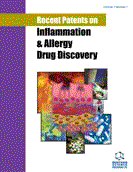Abstract
Background: Endothelial injury occurring during cardiopulmonary bypass is a major contributing factor in the development of organ dysfunction, which leads to many of the postoperative complications occurring during cardiac surgery.
Objective: This narrative review aims to summarize the main mechanisms of cardiopulmonary bypass - related disease, evaluating the unfavorable events leading to tissue injury, with a description of current pharmacologic and non-pharmacologic mechanisms to reduce CPB-related injury.
Methods: A Medline/Pubmed/Scopus search was conducted using clinical queries with the key terms "cardiac surgery", “cardiopulmonary bypass”, "inflammation" and “endothelial injury”, and related MeSH terms, until July 2019. The search strategy included meta-analyses, randomized controlled trials, clinical trials, reviews and pertinent references. Patents were searched using the same key terms from https://patents.google.com/, www.uspto.gov, and www.freepatentsonline.com.
Results: In this review, we discuss the current knowledge of the mechanisms of vascular endothelial cell injury, the acute inflammatory response, and the regulatory factors that control the extent of vascular injury during extracorporeal circulation, summarizing the main target of anti-inflammatory pharmacologic and non-pharmacologic strategies.
Conclusion: Inflammatory response and endothelial dysfunction following cardiopulmonary bypass are the prices to pay for the benefits offered during cardiac surgery procedures. Counteracting the detrimental effect of extracorporeal circulation appears to be crucial to improve clinical outcomes in pediatric and adult cardiac surgery. The intrinsic complexity and the tight interplay of the factors involved might require a holistic approach against inflammation and endothelial response.
Keywords: Cardiac surgery, cardiopulmonary bypass, cytokine scavenger, endothelial dysfunction, extracorporeal circulation, glycocalyx, inflammation, neuromodulation.
[http://dx.doi.org/10.1177/0267659109105079] [PMID: 19454559]
[http://dx.doi.org/10.1191/0267659104pf753oa] [PMID: 15506031]
[http://dx.doi.org/10.1097/ACO.0b013e32835c4ea2] [PMID: 23235524]
[http://dx.doi.org/10.1017/S1462399409001112] [PMID: 19563700]
[http://dx.doi.org/10.1161/01.RES.83.11.1115] [PMID: 9831706]
[http://dx.doi.org/10.1093/bja/aer515] [PMID: 22290457]
[http://dx.doi.org/10.1097/ALN.0b013e31829ab018] [PMID: 23719612]
[http://dx.doi.org/10.1016/j.ejcts.2008.12.037] [PMID: 19211261]
[http://dx.doi.org/10.1159/000083094] [PMID: 15637443]
[http://dx.doi.org/10.1016/j.jcrc.2009.06.009] [PMID: 19781902]
[http://dx.doi.org/10.1016/S0003-4975(03)01060-9] [PMID: 14726064]
[http://dx.doi.org/10.1053/j.jvca.2005.02.002] [PMID: 16458216]
[http://dx.doi.org/10.1016/S0003-4975(98)00965-5] [PMID: 9869436]
[http://dx.doi.org/10.1080/10739680600745992] [PMID: 16815825]
[http://dx.doi.org/10.1152/ajpcell.1994.267.4.C946] [PMID: 7943290]
[http://dx.doi.org/10.1016/S0022-5223(03)01028-6] [PMID: 14762364]
[http://dx.doi.org/10.1097/PCC.0000000000000759] [PMID: 27490610]
[http://dx.doi.org/10.1186/s13054-016-1570-4] [PMID: 27890016]
[http://dx.doi.org/10.1016/j.mvr.2014.04.004] [PMID: 24769132]
[http://dx.doi.org/10.1097/01.CCM.0000198525.82124.74] [PMID: 16424738]
[http://dx.doi.org/10.1165/ajrcmb/6.3.270] [PMID: 1540391]
[http://dx.doi.org/10.1172/JCI118074] [PMID: 7542286]
[http://dx.doi.org/10.1073/pnas.88.11.4651] [PMID: 1675786]
[PMID: 2747218]
[PMID: 1636722]
[PMID: 1992769]
[http://dx.doi.org/10.1126/science.286.5449.2511] [PMID: 10617467]
[http://dx.doi.org/10.1038/74725] [PMID: 10742156]
[http://dx.doi.org/10.1016/j.yexcr.2013.03.011] [PMID: 23500414]
[http://dx.doi.org/10.1186/s13054-016-1238-0] [PMID: 26951111]
[http://dx.doi.org/10.1172/JCI114374] [PMID: 2531759]
[http://dx.doi.org/10.1016/0952-7915(94)90006-X] [PMID: 7710711]
[http://dx.doi.org/10.1016/0092-8674(94)90337-9] [PMID: 7507411]
[http://dx.doi.org/10.1096/fasebj.8.8.8181668] [PMID: 8181668]
[http://dx.doi.org/10.1172/JCI114175] [PMID: 2472431]
[http://dx.doi.org/10.1172/JCI119129] [PMID: 9011572]
[http://dx.doi.org/10.1021/bi00107a001] [PMID: 1931959]
[PMID: 11073095]
[http://dx.doi.org/10.1093/cvr/cvt343] [PMID: 24385341]
[http://dx.doi.org/10.1097/MBC.0b013e328346ef3f] [PMID: 21597365]
[http://dx.doi.org/10.1016/j.athoracsur.2006.06.072] [PMID: 17126170]
[http://dx.doi.org/10.1016/j.molmed.2008.08.001] [PMID: 18774340]
[http://dx.doi.org/10.1177/1089253214532375] [PMID: 24876231]
[http://dx.doi.org/10.1097/SHK.0000000000000044] [PMID: 24088997]
[http://dx.doi.org/10.1038/nri3399] [PMID: 23435331]
[http://dx.doi.org/10.1007/s00281-008-0118-3] [PMID: 18536919]
[http://dx.doi.org/10.1097/01.CCM.0000114816.62331.08] [PMID: 15090940]
[http://dx.doi.org/10.1038/labinvest.3780193] [PMID: 11140695]
[http://dx.doi.org/10.1093/bja/aev411] [PMID: 26787791]
[http://dx.doi.org/10.1152/japplphysiol.01191.2011] [PMID: 22403352]
[http://dx.doi.org/10.1007/s00011-003-1199-z] [PMID: 14520520]
[http://dx.doi.org/10.1016/j.cyto.2012.04.002] [PMID: 22770562]
[http://dx.doi.org/10.1046/j.1469-7580.2002.00060.x] [PMID: 12162723]
[http://dx.doi.org/10.1161/hc37t1.094519] [PMID: 11568076]
[PMID: 16159815]
[http://dx.doi.org/10.1007/s00134-008-1174-9] [PMID: 18516587]
[http://dx.doi.org/10.1053/j.jvca.2014.03.004] [PMID: 25027103]
[http://dx.doi.org/10.1161/CIRCULATIONAHA.106.684852] [PMID: 17923576]
[http://dx.doi.org/10.1152/japplphysiol.00440.2007] [PMID: 18162484]
[http://dx.doi.org/10.1152/ajpheart.00218.2005] [PMID: 15964925]
[http://dx.doi.org/10.1152/ajpheart.00592.2005] [PMID: 16126814]
[http://dx.doi.org/10.1098/rsif.2011.0901] [PMID: 22417911]
[http://dx.doi.org/10.1146/annurev.bioeng.9.060906.151959] [PMID: 17373886]
[http://dx.doi.org/10.1161/01.CIR.84.6.2485] [PMID: 1659955]
[http://dx.doi.org/10.1159/000480431] [PMID: 29073603]
[PMID: 28979041]
[http://dx.doi.org/10.1152/jappl.1981.51.4.887] [PMID: 7298434]
[PMID: 8392414]
[http://dx.doi.org/10.1111/j.1749-6632.1982.tb21374.x] [PMID: 6953821]
[http://dx.doi.org/10.1371/journal.pone.0047254] [PMID: 23091614]
[http://dx.doi.org/10.1016/0140-6736(93)91412-F] [PMID: 8102722]
[http://dx.doi.org/10.1097/00000542-200112000-00017] [PMID: 11748396]
[http://dx.doi.org/10.1046/j.1525-1373.2000.22304.x] [PMID: 10632958]
[http://dx.doi.org/10.1213/ANE.0b013e3181c8b1bb] [PMID: 20081124]
[http://dx.doi.org/10.1213/ANE.0b013e3181bbc42e] [PMID: 19861361]
[http://dx.doi.org/10.1016/S0003-4975(00)02405-X] [PMID: 11235725]
[http://dx.doi.org/10.1189/jlb.1109766] [PMID: 20130219]
[PMID: 2709864]
[http://dx.doi.org/10.1203/01.PDR.0000147576.84092.F9] [PMID: 15531739]
[PMID: 8246579]
[http://dx.doi.org/10.1164/ajrccm.160.2.9809060] [PMID: 10430751]
[http://dx.doi.org/10.1152/ajpheart.00888.2003] [PMID: 14563666]
[http://dx.doi.org/10.1067/mtc.2002.121977] [PMID: 12063469]
[PMID: 8361191]
[http://dx.doi.org/10.1164/ajrccm.159.2.9803024] [PMID: 9927371]
[http://dx.doi.org/10.1161/01.CIR.88.5.2128] [PMID: 8222107]
[http://dx.doi.org/10.1177/026765919701200609] [PMID: 9413853]
[http://dx.doi.org/10.1161/01.CIR.100.7.749] [PMID: 10449698]
[http://dx.doi.org/10.1007/s00595-005-3124-2] [PMID: 16493527]
[http://dx.doi.org/10.1038/nm0509-497] [PMID: 19424210]
[PMID: 8302073]
[http://dx.doi.org/10.1056/NEJMra071667] [PMID: 17855673]
[http://dx.doi.org/10.1161/CIRCULATIONAHA.108.814640] [PMID: 19933949]
[http://dx.doi.org/10.1161/01.CIR.82.4.1402] [PMID: 2401073]
[http://dx.doi.org/10.1016/S0022-2828(88)80148-2] [PMID: 2851052]
[http://dx.doi.org/10.1016/j.amjcard.2010.03.032] [PMID: 20643246]
[http://dx.doi.org/10.1016/j.carpath.2005.03.006] [PMID: 16009313]
[http://dx.doi.org/10.1152/ajpheart.00006.2005] [PMID: 17085543]
[http://dx.doi.org/10.1056/NEJMra002709] [PMID: 11529214]
[http://dx.doi.org/10.1097/PCC.0b013e3181a64743] [PMID: 19451847]
[http://dx.doi.org/10.1097/PCC.0b013e3181ae4cc4] [PMID: 20051796]
[http://dx.doi.org/10.1210/endo-128-1-623] [PMID: 1702707]
[http://dx.doi.org/10.1016/S0003-4975(01)02486-9] [PMID: 11383777]
[http://dx.doi.org/10.1161/CIRCULATIONAHA.108.814533] [PMID: 19822810]
[http://dx.doi.org/10.1097/00003246-200203000-00029] [PMID: 11990932]
[http://dx.doi.org/10.1016/j.ejcts.2009.05.042] [PMID: 19692256]
[PMID: 2541628]
[http://dx.doi.org/10.1016/j.jtcvs.2005.02.046] [PMID: 16077384]
[http://dx.doi.org/10.1016/S0003-4975(03)01520-0] [PMID: 14759448]
[http://dx.doi.org/10.1191/0267659106pf871oa] [PMID: 16939115]
[http://dx.doi.org/10.1016/j.athoracsur.2003.10.034] [PMID: 15172281]
[http://dx.doi.org/10.1001/jama.1996.03530370045029] [PMID: 8596232]
[http://dx.doi.org/10.1378/chest.117.6.1706] [PMID: 10858406]
[http://dx.doi.org/10.1378/chest.124.6.2244] [PMID: 14665507]
[http://dx.doi.org/10.1093/icvts/ivw228] [PMID: 27371609]
[http://dx.doi.org/10.1016/j.pcl.2008.02.009] [PMID: 18501759]
[http://dx.doi.org/10.1016/j.ccm.2008.06.010] [PMID: 18954697]
[http://dx.doi.org/10.1016/S0022-510X(97)00154-8] [PMID: 9415530]
[http://dx.doi.org/10.1007/BF01743727] [PMID: 8923092]
[http://dx.doi.org/10.1097/00003246-200205000-00031] [PMID: 12006816]
[http://dx.doi.org/10.1097/01.CCM.0000240243.28129.36] [PMID: 16932228]
[http://dx.doi.org/10.1016/j.jtcvs.2011.09.011] [PMID: 21996297]
[http://dx.doi.org/10.1590/S0102-86502016001300010] [PMID: 27142905]
[PMID: 26357785]
[http://dx.doi.org/10.1016/S1010-7940(03)00164-7] [PMID: 12853056]
[http://dx.doi.org/10.1097/01.PCC.0000163678.20704.C5] [PMID: 15982431]
[http://dx.doi.org/10.1213/ANE.0b013e3181f333aa] [PMID: 20829561]
[http://dx.doi.org/10.1177/0267659109106730] [PMID: 19567543]
[http://dx.doi.org/10.1510/icvts.2010.233304] [PMID: 20385666]
[http://dx.doi.org/10.1097/MAT.0b013e3182816a75] [PMID: 23438770]
[http://dx.doi.org/10.1371/journal.pone.0191676] [PMID: 29370247]
[http://dx.doi.org/10.1186/s13063-016-1265-9] [PMID: 26971164]
 71
71 10
10 1
1



















